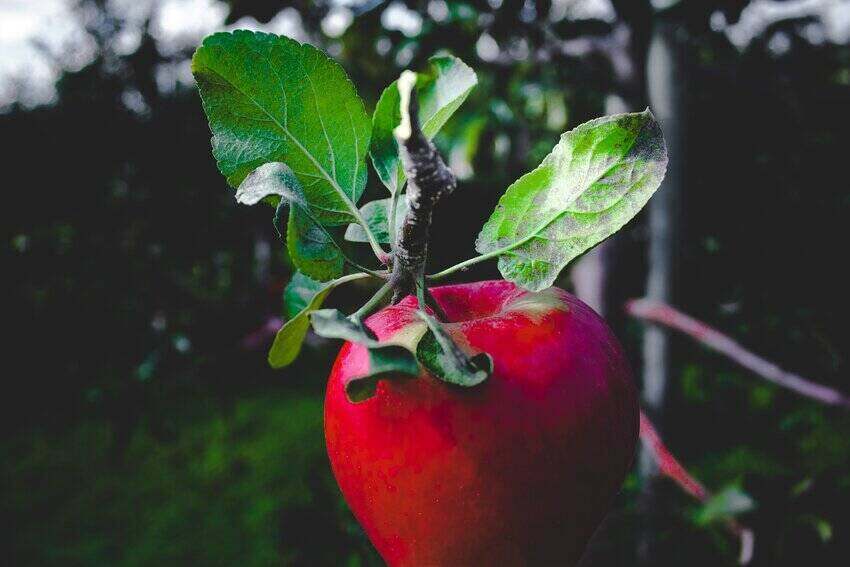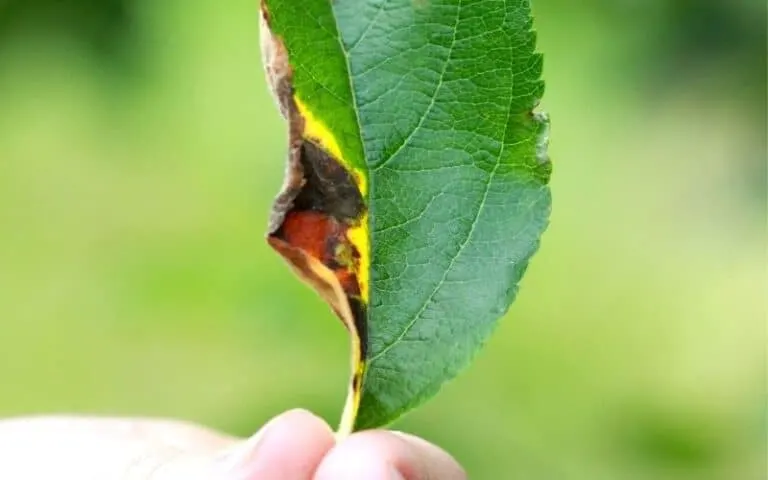Apple trees are typically easy to grow and need less maintenance that comes in a variety of cultivars, making them a great choice for rookie and experienced gardeners alike. Having said that, even the slightest anomaly in plants really does kindle a gardener’s anxiety, right?
We have noticed that people are showing great concern about their apple tree leaves turning red and so we have decided to dig down to figure out the reasons that cause this abnormal change in color.
So, let’s have a look at some of the common causes why apple tree leaves turn red with their treatments.
9 Causes and Solutions of Apple Tree Leaves Turning Red

The red leaves of apple trees do not necessarily indicate an unhealthy plant. There are some natural processes that might turn the leaves red. But, in some cases, the changes in color might be a matter of concern.
When you notice red leaves paired with other symptoms such as withering of leaves, brown edges, etc. during any other season, it might hint at health concerns. The good news is, that no matter what the cause is, they are generally fixable with proper treatment.
Below, we’ll cover 9 important reasons why the apple tree leaves turn red and how can you get rid of these problems.
1. Lack of Nutrients in Apple Tree Leaves
Apple trees require different nutrients in varying ratios at different stages of their lifecycle. The presence of certain macro and micronutrients such as nitrogen, phosphorus, potassium, calcium, magnesium, iron, etc. are essential for boosting the growth and maintaining the health of apple trees.
If the soil does not contain sufficient nutrients, the plant might not grow well. One of the signs of nutrient deficiency in apple trees, especially that of phosphorus is reddening leaves.
How to Treat It?
It is actually quite easy to fix this problem. Although optional, you might want to start off with a soil test to determine the health, fertility, and pH of the soil (which in turn affects the health of the plant) and to ascertain which nutrients the soil lacks.
Apple trees normally grow in a soil pH within the range of 5.8 to 7.0. If the soil test reveals a higher pH level, it means that the phosphorus content in the soil is low, causing red leaves.
Commercial fertilizers can help restore the nutrient elements back in the soil although better options are organic fertilizers (sometimes it may cause some issues like the green ball-shaped fertilizers) like manure or compost (i.e. slug compost if you like).

PH scale
Image Source: couchtohomestead.com
2. Seasonal Drop
In fact, apple tree leaves may turn reddish after harvest season in autumn before falling off (like an olive tree). Apple trees are deciduous, so they shed leaves in fall and winter and regrow them in spring.
Thus, as a natural process, the leaves might turn into different colors like orange, yellow, or sometimes red before they fall off. The shade depends on apple tree variations.
So, if you see red leaves in autumn there is nothing to worry about. But, when the color changes during spring or summer with discolored spots, it indicates something serious due to pests or diseases.
3. Anthocyanins Pigment Presence In Apple Leaves
Another reason why red hues may appear on apple tree leaves is the presence of a pigment called anthocyanin, which protects the leaves from damage caused by heavy sunlight. It’s frequently held in wild apple trees during autumn and turns the leaves bright red, which might be vulnerable.
According to Science Mag, the fact varies from region to region. For example, 62% of apple trees in central Asia turn red in Autumn, whereas 2.8% of British apple trees show it.
How to Treat It?
As anthocyanin pigment is a self-protective mechanism to protect the leaves from sunlight so there is nothing to worry about. Your tree knows how to keep itself safe.
4. Poorly Aerated Soil
If you notice reddish, wilting leaves that are smaller in size than regular leaves, it is likely to be caused by a deficiency of oxygen in the soil. To break down this further, the amount of oxygen present in the soil is dependent on the soil type and texture. That apart, compact and waterlogged soil also can cause a lack of oxygen supply to the soil.
Oxygen-deprived roots fail to process the uptake of nutrients and water in plants, which might eventually result in the roots dying. Also, oxygen-deficient plants are usually more vulnerable to other diseases. And all these are reflected in the reddening of the leaves.
How to Treat It?
Perhaps the easiest way of dealing with this problem is to poke holes into the soil with a spiking object, allowing oxygen to penetrate deeper into the soil. You can also consider using liquid aeration methods, which involve using liquid-based nutrients to seep into the soil and making air paths in the process.
If you have dwarf apple trees at home, you can also re-pot the plant to help loosen the soil to make more space to allow aeration.
5. Over or Under Watering
Plants breathe through the soil with their roots and overwatered plants with poor drainage will cause suffocation in plants since they cannot take in the gases from the soil. This is often indicated by red, withered leaves towards the lower part of the plant.
Overwatered plants tend to lead to the rotting of the roots and eventually cause the death of the plant. Similarly, underwatered pants might cause water deficiency in plants, leading to serious plant damage if it goes untreated.
How to Treat It?
If the apple trees are outdoors, it’s best to water them directly. Make sure, you apply sufficient water to the trees as surrounding water and grasses may drink some water. When the surrounding water is moist well, then stop watering. Also, avoid overwatering to prevent apple tree leaves from being red like avoiding the falling off olive tree leaves.
6. Too Much Lighting for Apple Leaves
While apple trees can thrive in direct sunlight for as long as eight hours straight, exposure to too much sunlight might result in sunburns and can therefore be detrimental to their health.
Yellow to reddish curled-up leaves (same as spinach) with brown edges, even in young foliage can be a sign that your tree is getting way too much light than it can take.
How to Treat It?
If your apple tree is exposed to overlighting, experts suggest either painting the lower branches and trunk of the tree or wrapping the tree with mesh or reflective materials. In case, make sure to keep just enough space for airflow.
If you have a potted plant, you can try introducing it slowly to direct sunlight and then increasing the sun exposure so that the tree has enough time to adapt to the light.
7. Genetics
There are numerous numbers of apple tree variants, each having different shapes, sizes, fruit textures, colors, etc. Some cultivars of apple trees, especially some wild variants have natural red leaves. In this case, it does not pose any significant threat to the health of the plant.
How to Treat It?
As this happens due to genetics, thus there is no fret to resolve it. Some gardeners like the red-leafed variants for ornamental trees and fruits. If you want to avoid this, you can try white seedings. But pink seedings will pose to red foliage.
8. Aphids
If apple tree leaves are curling like the curry plant up while turning red and have sticky buildup in the shoots, chances are the tree is sheltering aphids. Aphids are tiny bugs that feed on the sap of the trees, which weakens the tree over time.
Moreover, aphids produce a sticky sweet byproduct called the honeydew, which attracts other insects like ants (ants are also attracted to cucumber plants) and ladybugs and also results in the growth of fungus causing damage to the fruits and the tree.
The most common species of aphids that infest apple trees are the green apple aphid, rosy apple aphid, and wooly apple aphid among which, the latter is known to cause greater damage by forming galls on roots and twigs.
How to Treat It?
Aphids can multiply their population rapidly and the managing infestation can be intimidating. However, there are some solutions! Spraying high-pressure water can be helpful in removing pests. Similarly, insecticides can be used.
You can also make your very own insecticide at home with only two readily available ingredients. To make your own insecticide, mix 1.5 teaspoons of mild soap-like dishwashing liquid with 4 cups of water, mix them well together, and spray on the leaves and shoots.
Make sure to reach the underside of the leaves. Leave them for 15 minutes, and rinse them off using normal water. Having said that, these are not entirely effective, so you might want to prevent aphids in the first place.
Aphids lay eggs in the winter, so inspect your tree thoroughly during the season. Garlic and onions are also known to repel aphids. Growing flowering garlic and onions can help keep aphids away.
9. Cedar Apple Rust
Cedar Apple Rust is a type of fungus that can infect apple trees and affect the leaves and fruits. The process by which this rust fungus infests an apple tree is quite interesting. This rust needs two sets of different trees (Cedars/Junipers and Apples) to complete its lifecycle.
Cedar apple rust initially produces galls on red cedar trees, the spores of which then transfer to and settle on an apple tree and infect them.
It is pretty easy to detect if a tree is infected by the Cedar Apple Rust (also check the cedar pruning process if you are interested). You’ll see yellow-orange-red spots that enlarge over time. Although they do not really cause serious damage to the host plant, the leaves and fruits may suffer, and the fruit yield may lower with time.

Cedar Apple Rust
Image Source: couchtohomestead.com
How to Treat It?
It is to be noted that not all apple tree cultivars are susceptible to cedar-apple rust. In fact, some of them resist rust fully. In this case, prevention is better than cure and so our recommendation will be to opt for rust-resistant varieties of apple trees like Nova, Liberty, Freedom Fireside, etc.
Also, as a preventive measure, avoid planting juniper or red cedars within a few hundred yards of your apple trees. If the plant is already infected, you can use fungicides, although they are not fully effective once the symptoms start showing.
Also, chemical fertilizers are toxic and cause more harm to your tree and fruits than you bargained for. You can also try removing the infected twigs from the plant, which again might not be a hundred percent effective.
People Also Ask About Apple Tree Leaves Turning Red
Why did my apple tree die?
Apple trees, in fact, any plant will typically display a series of symptoms if they suffer from diseases and infestations or harsh weather conditions like too much lighting or over and underwatering.
Falling leaves, roots rotting and loosening from the soil, wilted brown leaves, etc. can indicate severe problems with your plant, which if go untreated may cause the death of the plant.
What is the average lifespan of apple trees?
There is no rule of thumb that determines the lifespan of apple trees. Healthy trees might live for 5o to 80 years, although this differs across the different cultivars of apple trees. Smaller domesticated plants might, for instance, live up to 20 years while semi-dwarf trees can live from 20 to 25 years.
Are falling apple tree leaves a cause of concern?
The simple answer is no. Due to seasonal drops, they might lose leaves in fall and spring. However, if leaves fall along accompanied by other symptoms like brittle brown leaves, you might want to inspect the tree.
What are some common apple tree diseases?
It is common for apple trees to be infected by a range of bacterial, viral, and fungal diseases. Some of the most common diseases in apple trees are Crown Gall, Fire Blight, Scab, Rust, Powdery Mildew, Flat apple, etc. Luckily, most of these diseases are preventable.
Educating yourself about the diseases and taking preventive measures beforehand can help save your tree from infestations.
Conclusion on Apple Tree Leaves Turning Red
So, getting to the question amateur gardeners have at the back of their heads – ‘should I be worried if my apple tree leaves are turning red?’ No, you should not!
Appletree leaves can bear a red hue seasonally or combat pests and sunlight and that is absolutely normal. But look out for deeper symptoms and treat your plants accordingly and your tree should be fine. Happy gardening!
Also, have a look at the reasons and cures for Asiatic lily leaves being yellow.
A video on why plant leaves turn red & how to cure them:

I’m Shofi, a passionate gardener and blogger. I have 10+ years of experience in gardening and hold certifications in horticulture and garden design. I share my knowledge and skills through my garden blog to inspire and educate others on the joys of gardening. I try to provide valuable information and create a community for gardeners of all levels to connect and learn. My ultimate goal is to inspire others to start their own gardens and connect with nature.

Is there a variety that grows red leaves as a saplings ???